Junjie Ye
AgentGym-RL: Training LLM Agents for Long-Horizon Decision Making through Multi-Turn Reinforcement Learning
Sep 10, 2025Abstract:Developing autonomous LLM agents capable of making a series of intelligent decisions to solve complex, real-world tasks is a fast-evolving frontier. Like human cognitive development, agents are expected to acquire knowledge and skills through exploration and interaction with the environment. Despite advances, the community still lacks a unified, interactive reinforcement learning (RL) framework that can effectively train such agents from scratch -- without relying on supervised fine-tuning (SFT) -- across diverse and realistic environments. To bridge this gap, we introduce AgentGym-RL, a new framework to train LLM agents for multi-turn interactive decision-making through RL. The framework features a modular and decoupled architecture, ensuring high flexibility and extensibility. It encompasses a wide variety of real-world scenarios, and supports mainstream RL algorithms. Furthermore, we propose ScalingInter-RL, a training approach designed for exploration-exploitation balance and stable RL optimization. In early stages, it emphasizes exploitation by restricting the number of interactions, and gradually shifts towards exploration with larger horizons to encourage diverse problem-solving strategies. In this way, the agent develops more diverse behaviors and is less prone to collapse under long horizons. We perform extensive experiments to validate the stability and effectiveness of both the AgentGym-RL framework and the ScalingInter-RL approach. Our agents match or surpass commercial models on 27 tasks across diverse environments. We offer key insights and will open-source the complete AgentGym-RL framework -- including code and datasets -- to empower the research community in developing the next generation of intelligent agents.
Feedback-Driven Tool-Use Improvements in Large Language Models via Automated Build Environments
Aug 12, 2025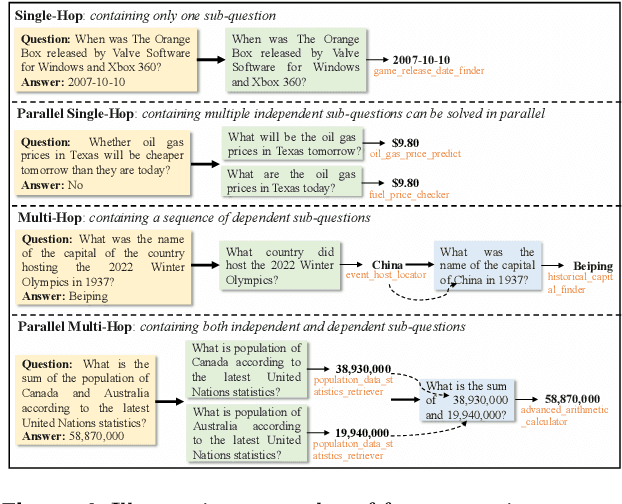

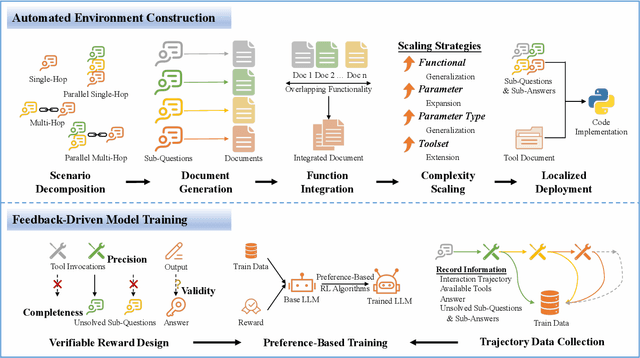
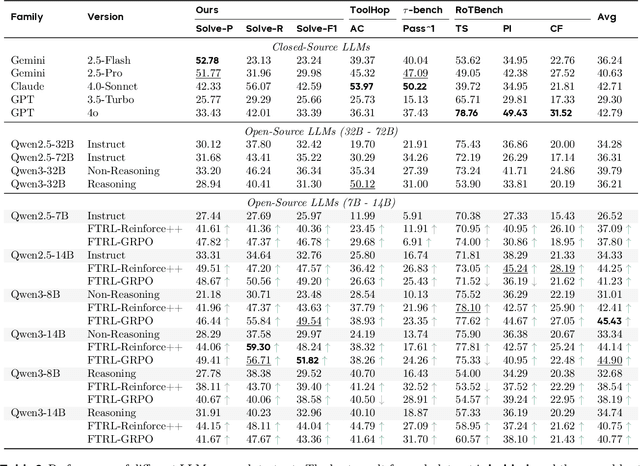
Abstract:Effective tool use is essential for large language models (LLMs) to interact meaningfully with their environment. However, progress is limited by the lack of efficient reinforcement learning (RL) frameworks specifically designed for tool use, due to challenges in constructing stable training environments and designing verifiable reward mechanisms. To address this, we propose an automated environment construction pipeline, incorporating scenario decomposition, document generation, function integration, complexity scaling, and localized deployment. This enables the creation of high-quality training environments that provide detailed and measurable feedback without relying on external tools. Additionally, we introduce a verifiable reward mechanism that evaluates both the precision of tool use and the completeness of task execution. When combined with trajectory data collected from the constructed environments, this mechanism integrates seamlessly with standard RL algorithms to facilitate feedback-driven model training. Experiments on LLMs of varying scales demonstrate that our approach significantly enhances the models' tool-use performance without degrading their general capabilities, regardless of inference modes or training algorithms. Our analysis suggests that these gains result from improved context understanding and reasoning, driven by updates to the lower-layer MLP parameters in models.
Speech-Language Models with Decoupled Tokenizers and Multi-Token Prediction
Jun 14, 2025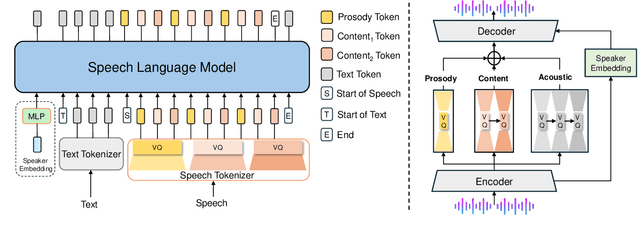
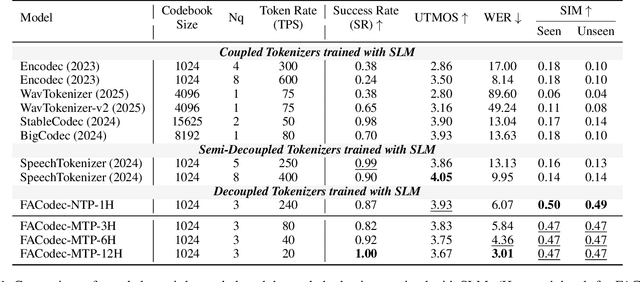
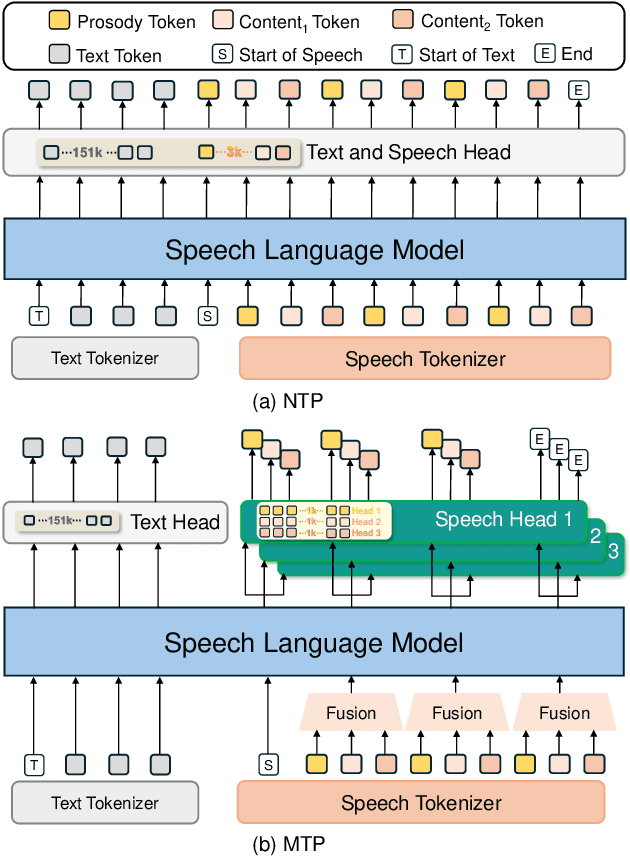
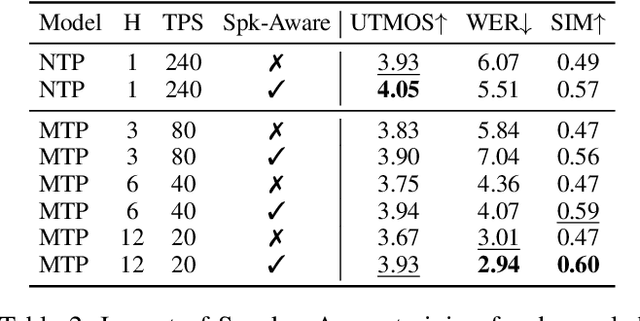
Abstract:Speech-language models (SLMs) offer a promising path toward unifying speech and text understanding and generation. However, challenges remain in achieving effective cross-modal alignment and high-quality speech generation. In this work, we systematically investigate the impact of key components (i.e., speech tokenizers, speech heads, and speaker modeling) on the performance of LLM-centric SLMs. We compare coupled, semi-decoupled, and fully decoupled speech tokenizers under a fair SLM framework and find that decoupled tokenization significantly improves alignment and synthesis quality. To address the information density mismatch between speech and text, we introduce multi-token prediction (MTP) into SLMs, enabling each hidden state to decode multiple speech tokens. This leads to up to 12$\times$ faster decoding and a substantial drop in word error rate (from 6.07 to 3.01). Furthermore, we propose a speaker-aware generation paradigm and introduce RoleTriviaQA, a large-scale role-playing knowledge QA benchmark with diverse speaker identities. Experiments demonstrate that our methods enhance both knowledge understanding and speaker consistency.
Fractional-order Jacobian Matrix Differentiation and Its Application in Artificial Neural Networks
Jun 09, 2025Abstract:Fractional-order differentiation has many characteristics different from integer-order differentiation. These characteristics can be applied to the optimization algorithms of artificial neural networks to obtain better results. However, due to insufficient theoretical research, at present, there is no fractional-order matrix differentiation method that is perfectly compatible with automatic differentiation (Autograd) technology. Therefore, we propose a fractional-order matrix differentiation calculation method. This method is introduced by the definition of the integer-order Jacobian matrix. We denote it as fractional-order Jacobian matrix differentiation (${{\bf{J}}^\alpha }$). Through ${{\bf{J}}^\alpha }$, we can carry out the matrix-based fractional-order chain rule. Based on the Linear module and the fractional-order differentiation, we design the fractional-order Autograd technology to enable the use of fractional-order differentiation in hidden layers, thereby enhancing the practicality of fractional-order differentiation in deep learning. In the experiment, according to the PyTorch framework, we design fractional-order Linear (FLinear) and replace nn.Linear in the multilayer perceptron with FLinear. Through the qualitative analysis of the training set and validation set $Loss$, the quantitative analysis of the test set indicators, and the analysis of time consumption and GPU memory usage during model training, we verify the superior performance of ${{\bf{J}}^\alpha }$ and prove that it is an excellent fractional-order gradient descent method in the field of deep learning.
A Multi-Dimensional Constraint Framework for Evaluating and Improving Instruction Following in Large Language Models
May 12, 2025Abstract:Instruction following evaluates large language models (LLMs) on their ability to generate outputs that adhere to user-defined constraints. However, existing benchmarks often rely on templated constraint prompts, which lack the diversity of real-world usage and limit fine-grained performance assessment. To fill this gap, we propose a multi-dimensional constraint framework encompassing three constraint patterns, four constraint categories, and four difficulty levels. Building on this framework, we develop an automated instruction generation pipeline that performs constraint expansion, conflict detection, and instruction rewriting, yielding 1,200 code-verifiable instruction-following test samples. We evaluate 19 LLMs across seven model families and uncover substantial variation in performance across constraint forms. For instance, average performance drops from 77.67% at Level I to 32.96% at Level IV. Furthermore, we demonstrate the utility of our approach by using it to generate data for reinforcement learning, achieving substantial gains in instruction following without degrading general performance. In-depth analysis indicates that these gains stem primarily from modifications in the model's attention modules parameters, which enhance constraint recognition and adherence. Code and data are available in https://github.com/Junjie-Ye/MulDimIF.
Measuring Data Diversity for Instruction Tuning: A Systematic Analysis and A Reliable Metric
Feb 25, 2025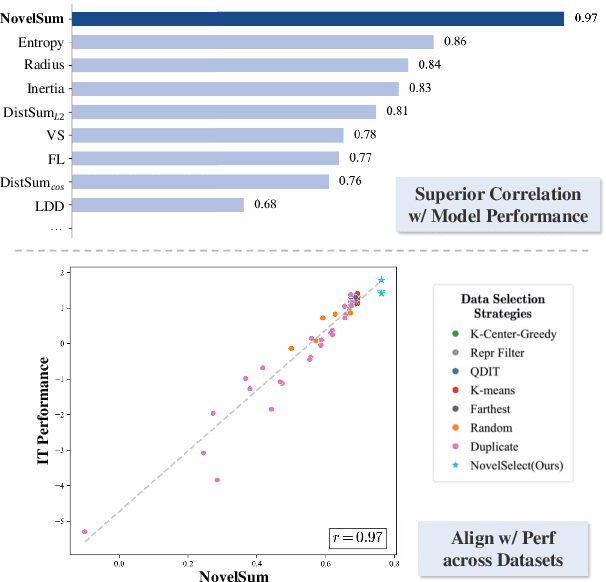
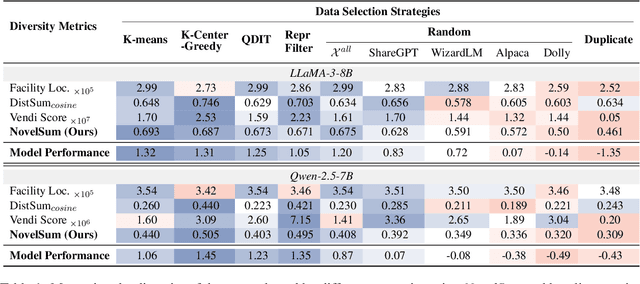
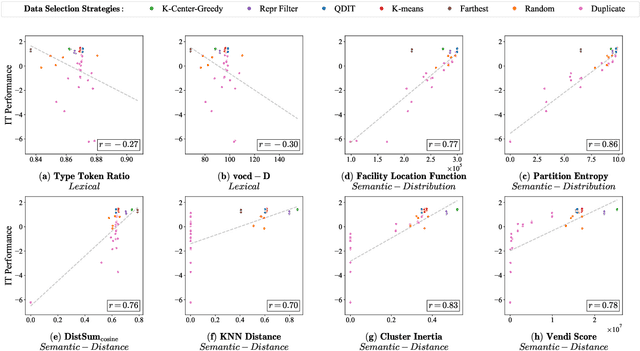
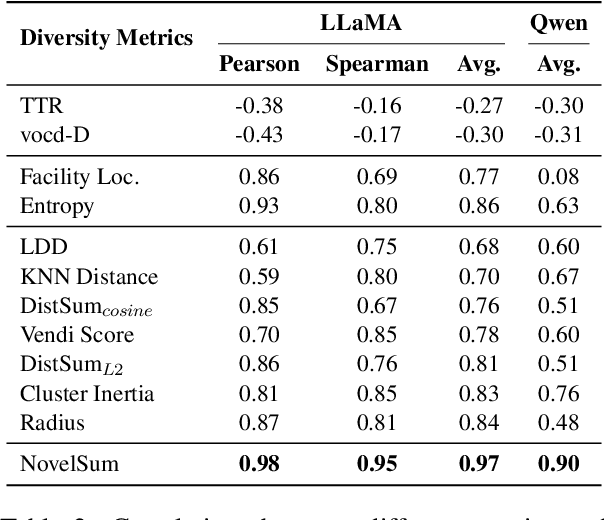
Abstract:Data diversity is crucial for the instruction tuning of large language models. Existing studies have explored various diversity-aware data selection methods to construct high-quality datasets and enhance model performance. However, the fundamental problem of precisely defining and measuring data diversity remains underexplored, limiting clear guidance for data engineering. To address this, we systematically analyze 11 existing diversity measurement methods by evaluating their correlation with model performance through extensive fine-tuning experiments. Our results indicate that a reliable diversity measure should properly account for both inter-sample differences and the information distribution in the sample space. Building on this, we propose NovelSum, a new diversity metric based on sample-level "novelty." Experiments on both simulated and real-world data show that NovelSum accurately captures diversity variations and achieves a 0.97 correlation with instruction-tuned model performance, highlighting its value in guiding data engineering practices. With NovelSum as an optimization objective, we further develop a greedy, diversity-oriented data selection strategy that outperforms existing approaches, validating both the effectiveness and practical significance of our metric.
SMART: Advancing Scalable Map Priors for Driving Topology Reasoning
Feb 06, 2025Abstract:Topology reasoning is crucial for autonomous driving as it enables comprehensive understanding of connectivity and relationships between lanes and traffic elements. While recent approaches have shown success in perceiving driving topology using vehicle-mounted sensors, their scalability is hindered by the reliance on training data captured by consistent sensor configurations. We identify that the key factor in scalable lane perception and topology reasoning is the elimination of this sensor-dependent feature. To address this, we propose SMART, a scalable solution that leverages easily available standard-definition (SD) and satellite maps to learn a map prior model, supervised by large-scale geo-referenced high-definition (HD) maps independent of sensor settings. Attributed to scaled training, SMART alone achieves superior offline lane topology understanding using only SD and satellite inputs. Extensive experiments further demonstrate that SMART can be seamlessly integrated into any online topology reasoning methods, yielding significant improvements of up to 28% on the OpenLane-V2 benchmark.
Predicting Large Language Model Capabilities on Closed-Book QA Tasks Using Only Information Available Prior to Training
Feb 06, 2025Abstract:The GPT-4 technical report from OpenAI suggests that model performance on specific tasks can be predicted prior to training, though methodologies remain unspecified. This approach is crucial for optimizing resource allocation and ensuring data alignment with target tasks. To achieve this vision, we focus on predicting performance on Closed-book Question Answering (CBQA) tasks, which are closely tied to pre-training data and knowledge retention. We address three major challenges: 1) mastering the entire pre-training process, especially data construction; 2) evaluating a model's knowledge retention; and 3) predicting task-specific knowledge retention using only information available prior to training. To tackle these challenges, we pre-train three large language models (i.e., 1.6B, 7B, and 13B) using 560k dollars and 520k GPU hours. We analyze the pre-training data with knowledge triples and assess knowledge retention using established methods. Additionally, we introduce the SMI metric, an information-theoretic measure that quantifies the relationship between pre-training data, model size, and task-specific knowledge retention. Our experiments reveal a strong linear correlation ($\text{R}^2 > 0.84$) between the SMI metric and the model's accuracy on CBQA tasks across models of varying sizes (i.e., 1.1B, 1.6B, 7B, and 13B). The dataset, model, and code are available at https://github.com/yuhui1038/SMI.
Agent-R: Training Language Model Agents to Reflect via Iterative Self-Training
Jan 20, 2025Abstract:Large Language Models (LLMs) agents are increasingly pivotal for addressing complex tasks in interactive environments. Existing work mainly focuses on enhancing performance through behavior cloning from stronger experts, yet such approaches often falter in real-world applications, mainly due to the inability to recover from errors. However, step-level critique data is difficult and expensive to collect. Automating and dynamically constructing self-critique datasets is thus crucial to empowering models with intelligent agent capabilities. In this work, we propose an iterative self-training framework, Agent-R, that enables language Agent to Reflect on the fly. Unlike traditional methods that reward or penalize actions based on correctness, Agent-R leverages MCTS to construct training data that recover correct trajectories from erroneous ones. A key challenge of agent reflection lies in the necessity for timely revision rather than waiting until the end of a rollout. To address this, we introduce a model-guided critique construction mechanism: the actor model identifies the first error step (within its current capability) in a failed trajectory. Starting from it, we splice it with the adjacent correct path, which shares the same parent node in the tree. This strategy enables the model to learn reflection based on its current policy, therefore yielding better learning efficiency. To further explore the scalability of this self-improvement paradigm, we investigate iterative refinement of both error correction capabilities and dataset construction. Our findings demonstrate that Agent-R continuously improves the model's ability to recover from errors and enables timely error correction. Experiments on three interactive environments show that Agent-R effectively equips agents to correct erroneous actions while avoiding loops, achieving superior performance compared to baseline methods (+5.59%).
Joint Antenna Selection and Beamforming Design for Active RIS-aided ISAC Systems
Jan 16, 2025



Abstract:Active reconfigurable intelligent surface (A-RIS) aided integrated sensing and communications (ISAC) system has been considered as a promising paradigm to improve spectrum efficiency. However, massive energy-hungry radio frequency (RF) chains hinder its large-scale deployment. To address this issue, an A-RIS-aided ISAC system with antenna selection (AS) is proposed in this work, where a target is sensed while multiple communication users are served with specifically selected antennas. Specifically, a cuckoo search-based scheme is first utilized to select the antennas associated with high-gain channels. Subsequently, with the properly selected antennas, the weighted sum-rate (WSR) of the system is optimized under the condition of radar probing power level, power budget for the A-RIS and transmitter. To solve the highly non-convex optimization problem, we develop an efficient algorithm based on weighted minimum mean square error (WMMSE) and fractional programming (FP). Simulation results show that the proposed AS scheme and the algorithm are effective, which reduce the number of RF chains without significant performance degradation.
 Add to Chrome
Add to Chrome Add to Firefox
Add to Firefox Add to Edge
Add to Edge